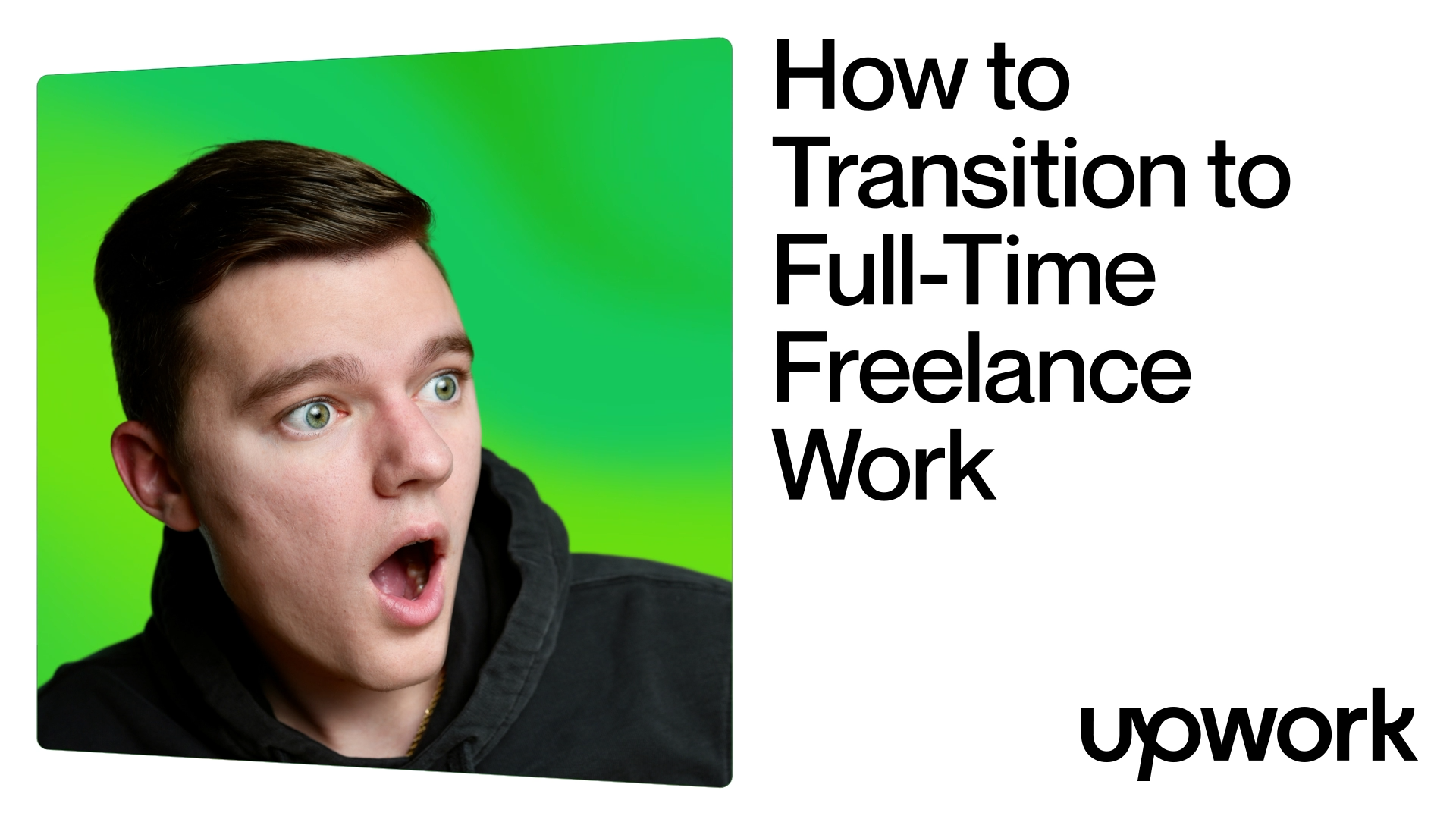Work From Home Productivity Tips
Freelancers get to choose when, where, and how they work. As a freelancer, you can work from wherever you want as long as you meet your deadlines. Shea has been working remotely for over three years and shares her best remote work hacks, productivity tools, and tips for working from home. She gives her freelancer advice for staying organized and maintaining work-life balance to avoid burnout and stay productive.
Upwork is not affiliated with and does not sponsor or endorse any of the tools or services discussed or shown in this video. These tools and services are provided only as potential options, and each viewer should take the time needed to adequately analyze and determine the tools or services that would best fit their specific needs and situation
You can read the full transcript of the video below:

Shea Lenniger: Are you struggling to stay productive when working from home? As someone who's now been working successfully from home for over three years, here is my ultimate guide to staying productive while working remotely. Let's go over everything from setting up your designated workspace to helpful productivity and time management tools to help keep you on track. So what are some factors to keep in mind when it comes to productivity?
First, think about your work environment. You should have a comfortable, bright, and organized workspace with limited distractions. Also, think about your work-life balance. The nice thing about working from home is that you're in charge of your own schedule. So make sure to find a good balance and to set a specific time for when you'll stop working. That way, you can prevent burnout.
Even when working from home, consider company culture. Even though you're working remotely, open communication, positive interactions, and digital collaboration with clients and coworkers can affect your productivity and motivation. Remember, your work environment directly impacts your productivity. So how can you choose the right workspace?
First, dedicate a workspace where you're able to focus. This helps you establish boundaries between work and home so your entire house doesn't become your workspace. Find a place with minimal noise and natural light. I find that sitting near a big window with light makes me feel happier and more productive overall. Be sure to organize your space. You don't need a whole room or an office.
Even just a desk with materials you may need and no clutter can become a great workstation. Also, remember that if you're sitting for six to eight hours a day, you will definitely need to invest in a good work chair that promotes good posture. Because when I work somewhere without considering my comfort and posture, I always end the day with sore shoulders and lots of tension in my neck, and that definitely won't help with my productivity and focus.
And remember to customize your desk. Find a sturdy desk that is large enough for all of your necessary work materials. You definitely don't want to use something that's flimsy or shaking because that will definitely interrupt your focus. Keep it organized and clutter free. For example, before I start work and even throughout the day, I make sure my desk doesn't become cluttered with papers or random notes. I try to limit it to necessary objects such as a pencil holder, a notepad, my laptop, maybe a beverage, and a candle or a plant.
As someone who's been working from home for a few years now, it's safe to say I have a pretty good system of staying organized and getting my tasks done efficiently.
So here are my best tips for creating an effective schedule and meeting those deadlines. First, it's best to list all of your tasks and categorize them so the most important tasks are done first. Otherwise, you might spend hours on a low-priority project and not give yourself enough time for something more urgent. So tackle the important and sometimes more difficult tasks first. That way, when you have less energy and maybe less motivation, you only need to worry about the simpler tasks later on.
I love to-do lists, and we'll talk more about the productivity tools that I use later in this video to help keep me on track, and that way I can visually see everything I need to get done and what I've already accomplished. Avoid multitasking. I, too, thought I was a person who could successfully multitask, whether that was working on something during a meeting or bouncing back and forth between projects. You're not really even being that much more productive, and in the end, it will probably lead to errors in your work and low-quality work. It's better to have your complete undivided attention on one thing at a time, and then move on to your next project once you're done.
I like to schedule my work day in time blocks and also make sure to include breaks. I've learned that giving yourself structure while working from home is really important, so I recommend scheduling out your workday in blocks. You can do this by scheduling out one- to two-hour blocks to work on a project, and then give yourself a break from the screen. So get up and walk around or stretch for 15 minutes between each block. Or you can try something called the Pomodoro technique, which is a really good option for people who get distracted easily or tend to try and multitask.
You set a timer to work for 25-minute increments with a five-minute break and repeat until the task is done. Another tip that really helps me is if you struggle with focusing, try using over- the-ear noise-canceling headphones. I really enjoy listening to ambient noise, lo-fi music, or classical music because it really helps me lock into my work. And again, don't forget about breaks. It's really important to get up and move.
Make sure you take a lunch break, go for walks, get up and do things around the house, and basically just give your brain a break so you can avoid burnout. Also, it's incredibly important to eliminate distractions. It can be difficult when working from home because there may be no one else around to keep you on track, but scrolling through social media or opening up your phone every few minutes is obviously a productivity killer. I like to put my phone on Do Not Disturb and actually place it far away from me, so not on my desk. That way, I'm not tempted to pick it up and scroll through it.
Also, be sure to quit iMessage or any non-work related services on your laptop because that can be really distracting as well. But obviously, work communication tools like Slack are definitely okay. Whether you're working from home, in an office, or a co-working space, you may find that avoiding distractions can be very difficult. But luckily, there are plenty of productivity tools to help keep you on track. So here are some helpful time-tracking productivity tools.
I personally love using Toggl to track my work. There's both manual and automatic timing, and you can start the timer as you start working and assign projects or tags to each time block. And it's a great tool to use for freelancers to use as a timesheet so that way clients can see exactly what you've been working on. Other options include Harvest, QuickBook Time, Everhour, and Upwork. For example, if you're working on hourly Upwork contracts, you don't need to use a separate timesheet tracker.
With the Upwork desktop app, you can actually use automatic time tracking, edit work diaries, and message the client directly. Now, if you're looking for digital note taking services, here are my recommendations. And remember, don't try to use all of these. Choose one that works best for you. Maybe you like the interface or it has the features that you need for your work.
Don't overwhelm yourself by trying to use all of these different applications. Evernote can serve as a daily task manager and a personal knowledge base. It has a dashboard, a calendar integrations, and text and list documents. Dropbox Paper is another option. It's a collaborative document editing tool that supports multiple file formats.
Then, of course, there's Google Keep or Google Docs. Keep is a lightweight note taking app designed for personal use, and Docs is very similar to Microsoft Word, and you can use it on your browser. And finally, my favorite Notion, which I use every day and I have been for years. Notion is a highly customizable document platform that combines notes, tables, and embeddable content into rich digital notebooks. It's my personal favorite because you can create many workspaces with templates, both private and collaborative, that I use for calendars, content ideas, document drafts, to do lists, income reports, and so much more, and it's all in one place.
Next, here are some project management tools for team productivity. So you have Asana, which has project briefing and approval tools, customizable project views, task automation, and built in forms for data collection. Then there's monday.com, which has ready to use templates, a workflow builder, eight ways to visualize data, task planning, and file sharing. Trello has private and shared boards, color coded project labeling, subtask, reminder notifications, and task automation workflows. Then if you find that you are struggling to stay focused, there are plenty of tools for that.
For example, Serene is a Mac desktop app that helps users identify a daily goal and then removes roadblocks to help you achieve it. Forest is an iOS app and Chrome extension that helps users resist phone and internet-based distractions through gamification. So each time you open the app, it displays a tree and an adjustable timer. If you do not leave the app for the entirety of the timer's countdown, the tree is planted in your digital forest. And if you do leave the app, you're left with a dead tree in your forest.
Then there's SelfControl, which is another Mac app that fully blocks any websites you add to a block list. This block persists until the end of the timer even if you close the app, delete it, or restart your computer. So it really keeps you on track. So now you have plenty of tips and resources to ensure that you stay as productive as possible while working from home. Remember, it's all about designating an organized workspace, taking breaks to ensure a good work life balance, and using productivity tools that help your workflow and promote better focus.
If you found this video helpful, be sure to check out even more productivity tips within Upwork's Resource Center. And if you're a freelancer working on hourly contracts through Upwork, remember to take advantage of their productivity tools built within their desktop app. Finally, don't forget to subscribe for more tips and tricks for freelancing on Upwork.






.png)
.png)
.png)
.png)
.png)



.svg)
.svg)













.svg)



%20(1).png)